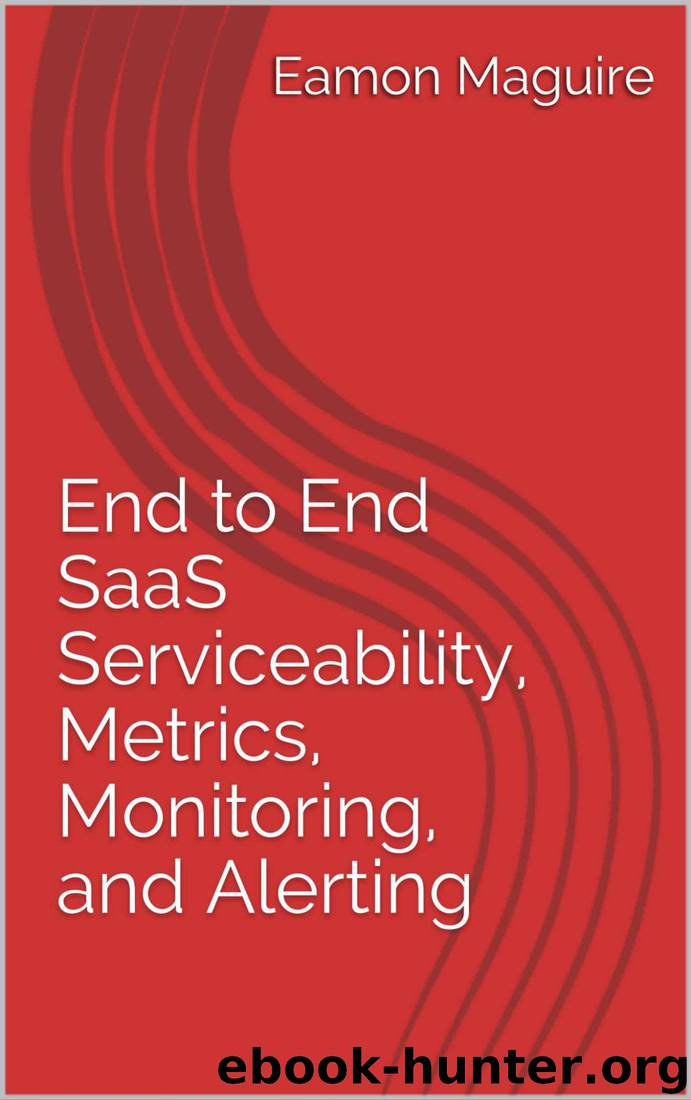End to End SaaS Serviceability, Metrics, Monitoring, and Alerting by Eamon Maguire

Author:Eamon Maguire
Language: eng
Format: azw3
Published: 2017-07-21T07:00:00+00:00
In this scenario, the "isAlive" check would communicate directly with service C. As a result, the "isAlive" check would find that service C is online and capable of servicing requests as expected, so no alert would be sent. If we had a monitor that informed us when our call volume was below a certain threshold value for a certain amount of time, we could be informed if there were some network issue, or other defect that prevented services from reaching us.
Beyond these couple of odd scenarios, however, we'll be applying monitors on the basis of our previously established reductive reasoning: ingress and egress points of the service, and general resources. That is, we'll apply rules such that all of our buckets of failures have an associated rule which will inform us if an API isn't satisfying QoS or correctness expectations.
How to Monitor
There are competing and varied schools of thought on the best way to approach monitoring, and a lot of depth as well. I've my own opinions based on experiences with a variety of approaches, and I'll expound upon the virtues of those in a moment. First though we should outline what it means to send an alert, and what precisely we expect.
An alert, by definition, is intended to get the attention of an on-call engineer. The expectation is that any monitor we've created has an expressly defined purpose, and reason for existing. An alert based off of a monitor needs to result in the ability of an on-call engineer to take a mitigating action to restore QoS or correctness.
On Apdex for Monitoring
A reasonably recently proposed solution with respect to the actual mechanism we use to implement our rules has emerged called "Apdex". I've worked with systems that utilized Apdex measurements before, and have a few gripes about it. In order to understand what I believe are shortcomings of the approach, we'll first need to have a basic understanding of the principle.
Download
This site does not store any files on its server. We only index and link to content provided by other sites. Please contact the content providers to delete copyright contents if any and email us, we'll remove relevant links or contents immediately.
Sass and Compass in Action by Wynn Netherland Nathan Weizenbaum Chris Eppstein Brandon Mathis(7837)
Grails in Action by Glen Smith Peter Ledbrook(7771)
Azure Containers Explained by Wesley Haakman & Richard Hooper(6919)
Configuring Windows Server Hybrid Advanced Services Exam Ref AZ-801 by Chris Gill(6912)
Running Windows Containers on AWS by Marcio Morales(6446)
Kotlin in Action by Dmitry Jemerov(5156)
Microsoft 365 Identity and Services Exam Guide MS-100 by Aaron Guilmette(5113)
Microsoft Cybersecurity Architect Exam Ref SC-100 by Dwayne Natwick(4698)
Combating Crime on the Dark Web by Nearchos Nearchou(4685)
Management Strategies for the Cloud Revolution: How Cloud Computing Is Transforming Business and Why You Can't Afford to Be Left Behind by Charles Babcock(4440)
The Ruby Workshop by Akshat Paul Peter Philips Dániel Szabó and Cheyne Wallace(4376)
The Age of Surveillance Capitalism by Shoshana Zuboff(3999)
Python for Security and Networking - Third Edition by José Manuel Ortega(3930)
Learn Wireshark by Lisa Bock(3609)
The Ultimate Docker Container Book by Schenker Gabriel N.;(3596)
Learn Windows PowerShell in a Month of Lunches by Don Jones(3536)
Mastering Python for Networking and Security by José Manuel Ortega(3381)
Mastering Azure Security by Mustafa Toroman and Tom Janetscheck(3370)
Blockchain Basics by Daniel Drescher(3339)
